1958 Italian Grand Prix race report: Brooks outruns the Ferraris
Tony Brooks claims his third victory of the season after Mike Hawthorn's Ferrari fails ten laps from the finish
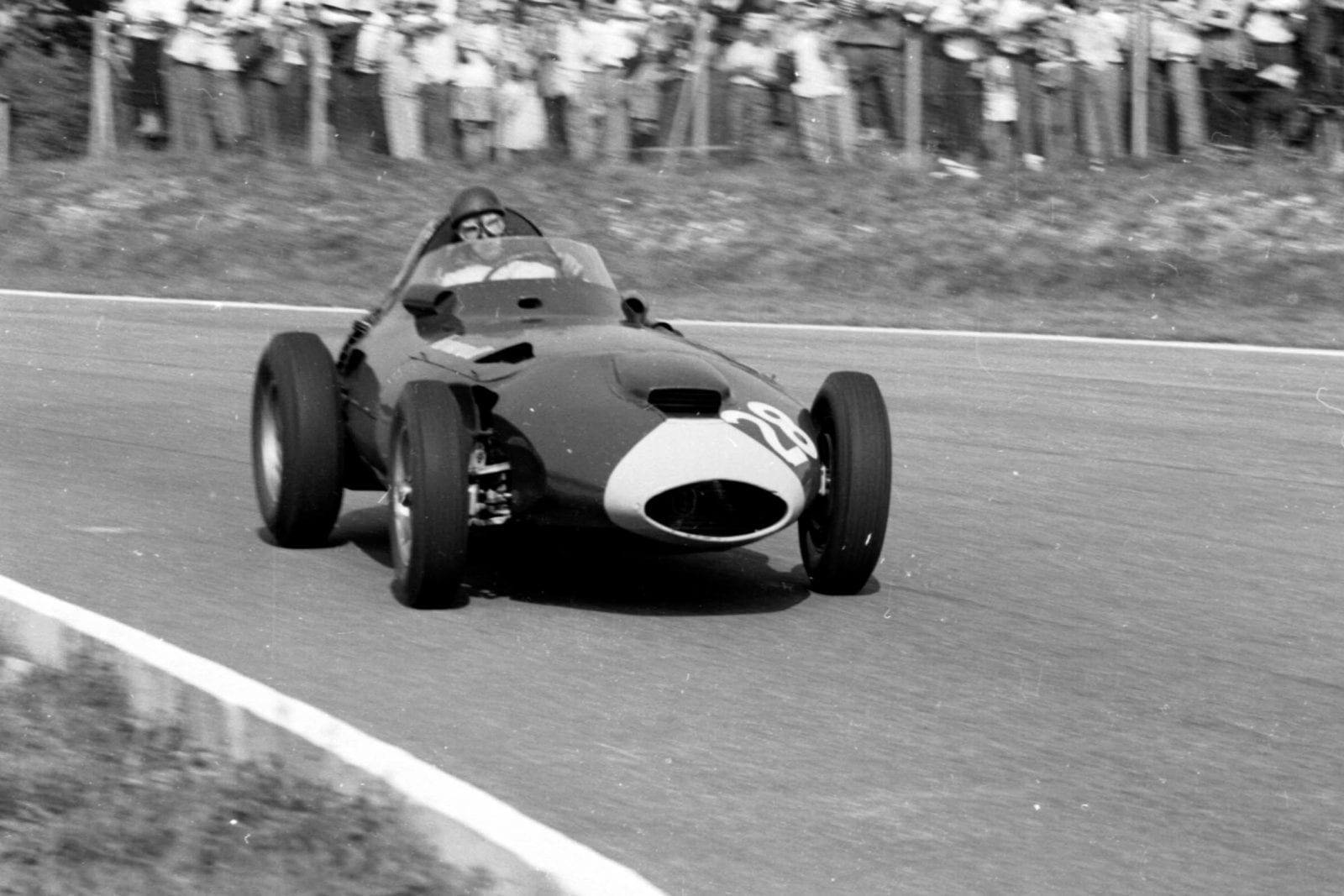
Victory Tony Brooks rounds Curva Sud in his Vanwall
Practice was due to be held on the afternoons of Friday and Saturday preceding race day, but as always happens before the Italian Grand Prix, there was lots of activity throughout the week, Ferraris testing on one day, Maserati another, then BRM and then Vanwall, while down at Maranello Ferrari was busy working away on his brake problems and at Modena Maserati were preparing two 1958 cars.
Vanwall entered three cars for his brilliant trio of Moss, Brooks and Lewis-Evans; BRM entered Behra, Schell and Bonnier; Ferrari entered four cars with a truly mixed team of drivers, Hawthorn, von Trips, Phil Hill and Gendebien, and Scuderia Buell entered Gregory on a new Maserati and were trying to get Shelby in on the other Maserati, though he was due to drive for Centro-Sud.
The Rome stable also entered Gerini in a Maserati, and Bonnier entered two Maseratis to be driven by Cabianca and Herrmann, while de Filippis entered her own car. Cooper Cars entered Brabham and Salvadori, as always, and Trintignant was in RRC Walker’s Cooper, while Team Lotus entered Allison and Graham Hill to complete the list of runners.
Qualifying
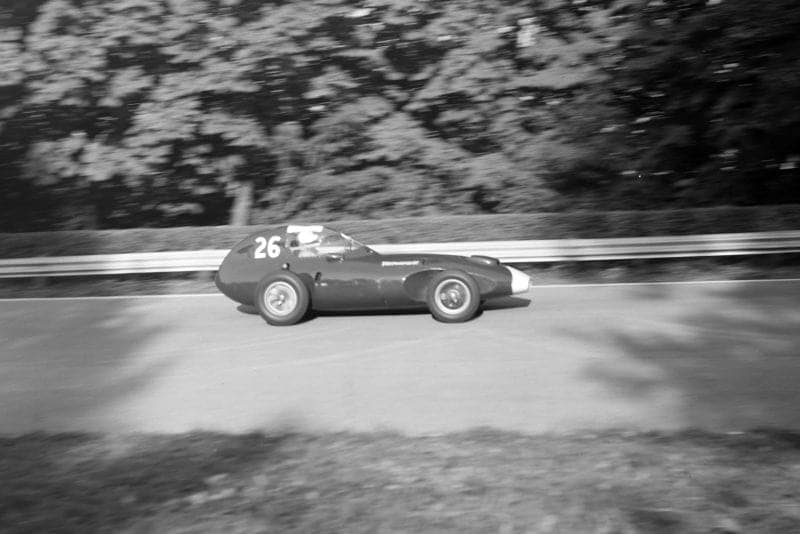
Stirling Moss tests a closed cockpit on his Vanwall
Motorsport Images
On Friday afternoon, under a hot sun, the Automobile Club of Milano officials got into their usual excited state, aided and abetted by the Italian police and, amid the usual confusion that has become part of the Monza scene, practice got under way at 3:30pm, 30 minutes late. Behra was first away in a BRM and soon Hawthorn and von Trips were following, both having the enlarged Dino 256 engines, the English driver’s car having disc brakes.
One after another cars went away from the pits, Salvadori, Trintignant, Moss with the first of the Vanwalls, Phil Hill having his first F1 drive for Ferrari, Gendebien in the experimental Ferrari, Cabianca having his first go in a F1 car, Graham Hill in the cigar-shaped 1958 Lotus, and so on.
Soon the track was full of activity and the Ferraris were going round in 1min 45sec and Behra and Moss in 1min 46sec. Bonnier had a go in one of his own Maseratis before trying a BRM and Gregory was out in the new Maserati, his first appearance since his Silverstone crash in the Lister-Jaguar.
Behra was trying all three BRMs at various times and there was so much activity that traffic-conditions prevented anyone making any meteoric laps, so almost as though someone had given a signal there was a lull after 30 minutes and Brabbam was left circulating on his own, but not for long as Schell appeared with the number two BRM and Moss went out again in his Vanwall.
Once again there was a rush as everyone scented afraid someone fast was going to have a clear track; Gregory went out and began trying really hard through the corners, Phil Hill was really getting the hang of F1 car driving, and at long last Lewis-Evans was let out. Moss was getting below 1min 43sec and Lewis-Evans was not far off, while Hill was keeping up with them, but the BRMs of Behra and Bonnier were sticking at around 1min 45sec.
The aim was to get below 1min 42sec as last year Lewis-Evans had done 1min 42.4sec, and whereas 1min 50sec had been a reasonable time last year, it was now obvious that 1min 45sec was to be a minimum, anything over that being left behind. Since last year the long fast bend after the pits straight had been resurfaced and some bumps removed, but whether this was an advantage or not seemed open to question among the drivers.
“The long fast bend after the pits straight had been resurfaced and some bumps removed, but whether this was an advantage or not seemed open to question among the drivers”
There was a hint of a discussion as to whether Shelby was driver for Buell or Centro-Sud, but in the meantime he went out in the second Buell Maserati, the one he drove in Portugal, and then Moss fitted the bubble top to his Vanwall and went out. It proved highly successful from the driver’s viewpoint but its speed advantage seemed doubtful, though the Vanwall was going well with or without its top.
Shortly after 5pm there was another lull and a lone Maserati was left circulating, this being Bonnier’s old car with his Swedish friend Norrinder driving it. Having been testing the Vanwall the previous day Brooks did not go out until near the end of practice and was soon down below 1min 43sec, and did a final 1min 42.0sec, which left him with FTD, Moss being unable to retaliate as he had broken his engine when he missed a gear-change.
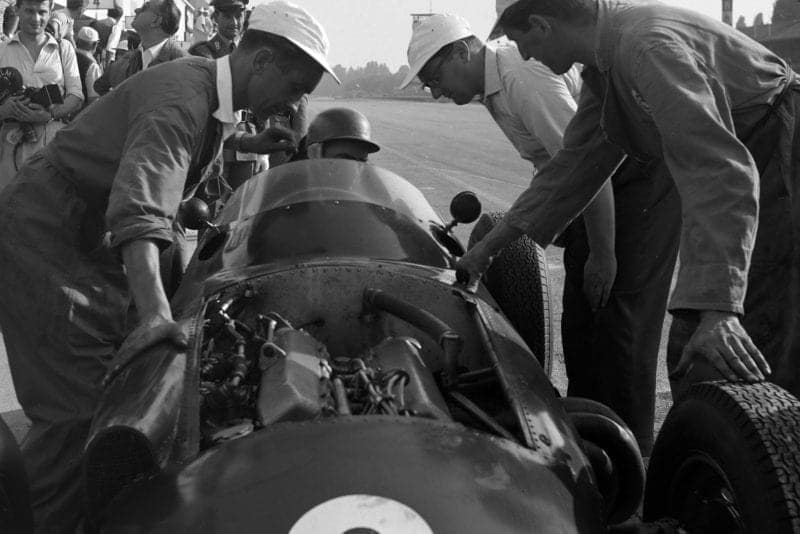
Behra’s BRM in the pits
Motorsport Images
Gregory was trying very hard, doing some real Fangio stuff in the Lesmo corners. but the new Maserati was down on maximum speed and the brakes were not happy, so that Gregory’s times were down amongst the baby-cars, of which Allison was the fastest at 1min 47.8sec, but his practice had been stopped when a big-end bolt broke and the rod tied itself in a knot and came out through the side of the crank case.
The afternoon finished with Brooks fastest, ahead of Moss, Phil Hill, Lewis-Evans, Hawthorn and von Trips, the German driver having done 1min 44sec, and all the remaining runners taking longer than 1min 45sec. It was obvious that Vanwalls were on form, but surprise of the day had been the young American driver Phil Hill, and even Enzo Ferrari, who was in the pits, must have realised he had been hampering this promising driver for long enough, keeping him locked under contract to waste his time on sports cars.
Next day practice started amidst the same confusion but this time promptly at 3pm, and there were sonic changes to be seen. Ferraris had replaced the Dino 256 engine by a 246 in Hawthorn’s car and all four cars had the metal bulges over the down-draught carburetters replaced by Perspex ones. Vanwalls had abandoned the “bubbletop”, removing the additional skin from the tail and fitted a new engine to the car, BRM had four cars at the pits and Rob Walker had two.
Both Buell Maseratis were numbered 32 as Shelby had to drive a Centro-Stid Maserati, so Gregory could choose between the two 1958 cars. Almost as soon as the track was opened, Phil Hill, von Trips and Behra were away, and then everyone was thrashing round, some fast and some slow, and the Vanwalls were the last to join in. The general pace was extremely fast, especially among the real Grand Prix cars, and there was some pretty furious braking going on at the South Curve, while Moss and Gregory were taking this long, smooth hairpin in full-opposite lock power slides.
“The pace was extremely fast, especially among the real Grand Prix cars”
Once everyone had get the “feel” of the afternoon there was a pause and Allison was left going round on his own, his old Lotus having a 1,500cc fitted in place of the blown-up 2-litre Climax. Then things began to get stirred up and Hawthorn, Lewis-Evans and Moss began to make it obvious that they were trying really hard and their times, by hand-timing, agreed. Hawthorn and Moss were below 1min 42sec and Lewis-Evans was only just over that figure, and while this went on Schell cruised round waiting for other drivers and tucked in behind as they passed to see how the BRM measured up to the opposition.
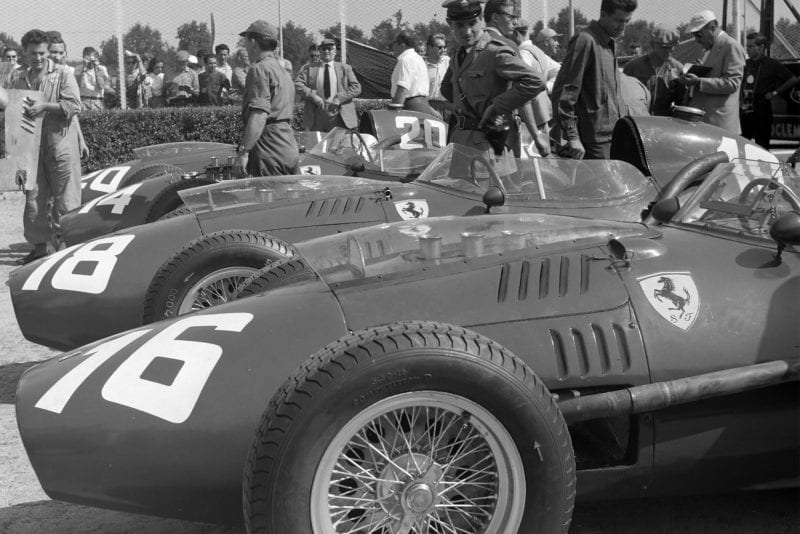
The Ferraris line-up before the race
Motorsport Images
It did not, as he could not break 1min 43sec, nor could Behra, though they weren’t completely left behind. Best of the small cars was Graham Hill with the 1958 Lotus in 1min 46sec, fast by last year’s standards but not fast enough for this year. Both von Trips and Phil Hill had got below 1min 43sec in their outing in the early part of the afternoon, and Ferrari decided that was enough and they were put away for the rest of’ the afternoon. Gregory at last broke the bogey-time of 1min 45sec, but Shelby stopped his practice very suddenly when a drive shaft broke on the Centro-Sud car and he spun at very high speed.
As the cool of the evening descended there was another lull and Norrinder went out in the Cabianca Maserati, and Munaron tried de Filippis’ Maserati. Then, 30 minutes before the end of practice there was a mad rush for the front row of the grid and we saw some really high-speed driving. All three Vanwalls were at the limit, as was Hawthorn with the Ferrari and also Gendebien. Moss did a remarkable 1min 40.5sec, which the time-keepers found hard to believe and took a long time to confirm.
This last-minute thrash round was kept up until the end of the practice time and the result was that everyone improved on their times of the previous day and three Yeomans and a Ferrari shared the front row, but only tenths of a second decided the second row, which really does call for beam-timing now that the starting grid is so vital in today’s short races.
The Centro-Sud team brought along another car for Shelby, to replace the one broken in practice and he sat in it for the first time on the starting line, only to find that the cockpit was laid out for someone half his size. Gregory decided to use the Reims car of the two new Maseratis, and all three BRMs were 1958 ones.
Race

Hawthorn attacks the final turn at Monza
Motorsport Images
As always, the start at Monza was truly impressive, especially when seen from the top of the main grandstand, and as the flag fell Hawthorn’s Ferrari hesitated and the three Vanwalls leapt ahead with Lewis-Evans drawing away. Hawthorn gave a quick jab on the clutch pedal, got the revs, up and then took off in a haze of tyre smoke and wheelspin. In row two Gendebien was also having trouble getting off the mark and was rammed in the back by Brabham, but Phil Hill had made a superb start and as the three Vanwalls went off the American shot past the lot of them. Gendebien and Shelby were left behind after the pack had gone and they got going on their own, but meanwhile there was much excitement round the course.
As the pack braked for the first of the Lesmo corners there was the usual pushing-and-shoving and in the midst of it all von Trips ran into the back of Schell’s BRM. The Ferrari rode up the rear wheel of the BRM, going high into the air, the driver was flung out and the car bent itself double against a tree. Meanwhile the BRM had gone off the road, end over end, to land on its wheels in the bushes, Schell luckily staying in the cockpit. The result of all this was a leg injury to von Trips and bruises and scratches to Schell and two bent cars, the Ferrari being reduced to scrap metal.
“The Ferrari rode up the rear wheel of the BRM, going high into the air, the driver was flung out and the car bent itself double against a tree”
Out in front Phil Hill was really enjoying himself in his first proper Grand Prix race, for having got the lead he pressed on leaving a panting Moss, Lewis-Evans, Hawthorn, Brooks, Bonnier and Behra trying to catch him. As the American passed the pits in the lead the cheers were loud for this popular and talented driver. At the end of the field Brabham pulled into the pits to retire with a bent front-end as a result of the starting-line collision and on the next lap Shelby retired as not only did he not fit the borrowed car but all the wheels were out of balance and the whole car vibrated at high-speed.
Lap two had seen the first 13 cars pass in quick succession, Hill, Moss, Evans, Hawthorn, Brooks, Behra, Bonnier, as quick as that but by the end of lap three a gap began to appear after Trintignant and Salvadori who were 10th and 11th. Down the back straight on lap four Hawthorn went by Moss into second place but Phil Hill was still playing “catch-me-if-you-can” and looking very comfortable and relaxed out in the lead.
By lap five the race had split up into three groups, Hawthorn now having taken the lead followed closely by Phil Hill, Moss, Evans, Brooks and Behra, all nose-to-tail; after some seconds came Bonnier, Graham Hill, Gregory and Trintignant having a terrific ding-dong, and then came the also-runs, while Gerini had already retired after overshooting the South Curve and bumping the bank. Gendebien came into the pits and retired as the de Dion tube of his Ferrari was bent by Brabham at the start, so already the field looked a bit thin with six cars out in five laps.
On the seventh lap as he was rounding the South Curve Phil Hill had a tread come off his left-rear tyre and he pulled in for a wheel change, leaving the tight group for the lead to go on their way, this lap with Moss in the lead, but all five cars were so closely matched that anyone could be leading.
Before Hill could rejoin the race the four cars in the second group went by and then Salvadori stopped with overheating, to continue later after air-locks had been got out of the water system. Although Moss was now in the lead it was by only a very small amount and more often than not Hawthorn was up alongside trying to pass, while Evans, Brooks and Behra were right behind the leading pair. Graham Hill dropped back from the second group on lap eight when a consistent misfire set in on the Climax engine of the Lotus, but Trintignant stayed with the big cars of Bonnier and Gregory.
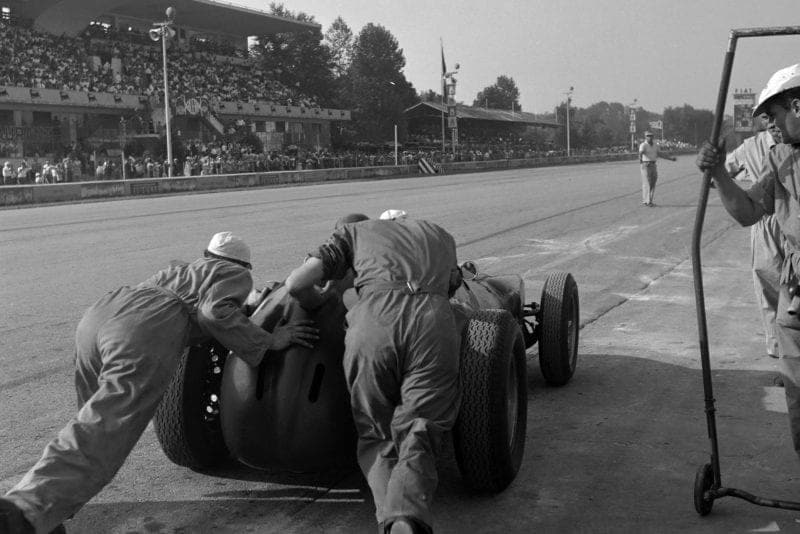
Behra gets a push out of the pits
Motorsport Images
On lap 13 Brooks dropped out of the leading bunch of cars and visited the pits to point out an oil-spray coming front the rear-end; it was only a split rubber gaiter on a drive shaft and the leak was not serious so he was sent back into the race, having been passed by Gregory, Bonnier, Trintignant and Phil Hill. Just as the Vanwall set off Graham Hill brought the Lotus in to look for the misfire and the leading group went by, having lapped the tail-enders.
Bonnier began to lose ground to Gregory and Trintignant and on lap 15 the reason became visible as smoke rose from under the driving seat, for something in the transmission was seizing up. Hawthorn had now retaken the lead and Behra and Lewis-Evans were right up with Moss and on lap 16 Behra took second place, but on the next lap was pushed back to fourth behind the two Vanwalls.
On lap 18 Moss was missing and as Hawthorn went by firmly in the lead, ahead of Evans and Behra, Moss was seen going slowly down the back straight and he drew into the pits to retire with gearbox trouble. Hawthorn was lapping steadily at 1min 45sec and at 20 laps, with the race less than a third through, the total distance being 70 laps, he had 7sec over Lewis-Evans and Behra who were still wheel-to-wheel.
“With the race barely begun mechanical trouble had been rife”
After a long gap came Gregory and Trintignant, with Phil Hill now between them, the American Ferrari driver still going hard to make up for his tyre change. Another long gap and there came Brooks, his Vanwall going as well as ever, and the rest of the field, consisting of Herrmann, Graham Hill, Cabianca, Allison, de Filippis and Salvadori had all been lapped.
With the race barely begun mechanical trouble had been rife but there was more to come, for Lewis-Evans began to make signs of distress and he dropped back behind Behra on lap 22, while Hill in the Lotus was coming on less and less cylinders and he stopped at the pits again to find where the sparks were going, for they were obviously not getting to the plugs.
Then Trintignant’s excellent run ended abruptly as the special high top gear broke up with a grinding crash and on lap 29 Behra ran into front brake troubles and stopped at the pits. Meanwhile, Hawthorn was safely out in front with Phil Hill pounding along behind, moving into third place when Behra stopped, and credit for a new lap record went to the American on lap 26.
Almost overlooked, Brooks was now fifth, this being lap 30 and he was lapping a lot quicker than Hawthorn but having been almost a full lap in arrears when he restarted from his pit stop few people, least of all the Ferrari pit, gave much thought to his progress. Behra’s stop put him back to sixth place, now a lap behind Hawthorn and on lap 31 Lewis-Evans drew into the pits with a very overheated water system, a suspected warped head having caused all the water to boil away. There was no possibility of continuing so another Vanwall was wheeled away and Ferraris were now first and second and Gregory was now third, a very consistent piece of driving at last paying off.
Herrmann’s engine then went rough and he retired at the pits and at half distance, with a lead of 38sec Hawthorn came in to change rear tyres as Ferraris were not happy about the lasting qualities of the Engleberts. While Hawthorn was at the pits Phil Hill went by into the lead and as the disc-braked Ferrari rejoined the race Gregory in the blue and white Maserati was coming up fast.
Lap 36 saw Phil Hill leading, followed by Gregory and Hawthorn the Maserati driver having got by while Hawthorn was getting used to the new rear tyres, but meanwhile Brooks was closing up more and more, driving on remorselessly still unnoticed by the Ferrari pit who busily engaged on tyre changing preparations.
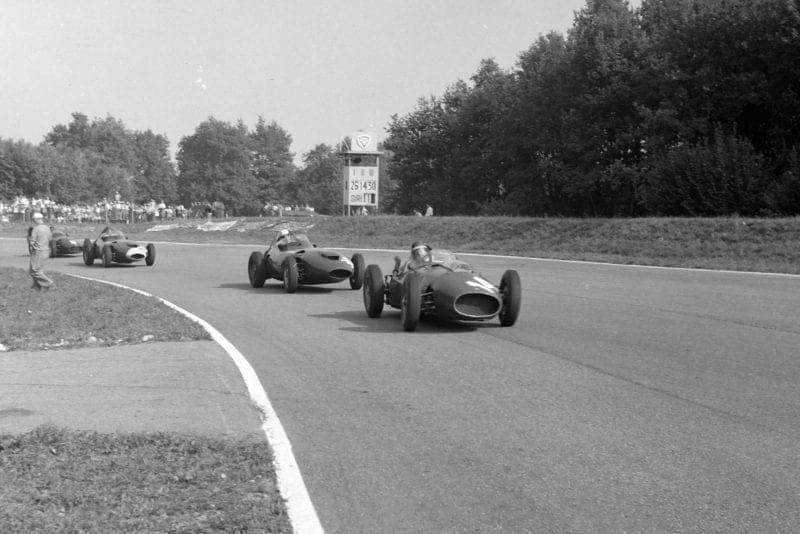
Mike Hawthorn leads Stuart Lewis-Evans Tony Brooks and Jean Behra.
Motorsport Images
On lap 37 Phil Hill pulled in for a new rear tyre on the right and Hawthorn, having re-passed Gregory, went by into the lead with the blue and white Maserati right on his tail. Before Phil Hill could rejoin the race Brooks had gone by into third position and the Ferrari pit woke up with a start and signalled the danger to Hawthorn, but he was already having a bad time from Gregory, for the boy from Kansas City was really having a go and sitting right on the tail of the Ferrari.
Rather overlooked by all this excitement Behra’s race came to an end when the BRM clutch gave up and with brakes and clutch up-the-slot a well-known trade representative tried to disappear into the ground. Allison stopped with the old Lotus to see if there was any oil in the gearbox oil tank as he seemed to be soaked in oil and went on again as all was apparently well, while the other Lotus was now running all right the leaking sparks being traced to a split plug lead.
For nine laps Gregory hung on to Hawthorn, but then he had to come in for new rear tyres and once stopped he was physically clapped-out, this being his first race since his big Silverstone crash and he had been working hard. Brooks had gone by into second place and his consistent driving had nibbled Hawthorn’s lead down to a bare 8sec, while Phil Hill was in third place 22sec behind the Vanwall and Shelby took over the Buell Maserati now in fourth place and setting out to merely finish for the rest of the runners, consisting of Cabianca, Salvadori, de FiIippis, Allison and Graham Hill were so far behind as to be almost in another race.
At 50 laps the situation looked secure, Hawthorn, Brooks and Phil Hill all lapping at 1min 45sec, a lap time Hawthorn had been doing ever since the start of the race, for there had never been an opportunity to relax. On lap 51 Brooks gained 0.5sec and on lap 52 there was the ominous sound of clutch-slip from the Ferrari as Hawthorn changed into top gear after the pits.
On the next lap the sound of the engine revs not coinciding with the speed of the car could be heard again and now it was certain that the Ferrari was in trouble and second by second and lap by lap Brooks closed relentlessly on the stricken Ferrari.
“On lap 60 Brooks had the nose of the Vanwall almost touching the tail of the Ferrari as they passed the pits”
On lap 60 Brooks had the nose of the Vanwall almost touching the tail of the Ferrari as they passed the pits and then he pulled out of the slip-stream and went by into the lead and there was nothing that Hawthorn could do about it except to nurse the car along and hope the clutch would hold out for another ten laps.
Phil Hill was securely in third place and Shelby was touring quietly round in Gregory’s Maserati a safe fourth. A triumphant Brooks reeled off the last ten laps while Hawthorn went slower and slower, being very relieved to see the chequered flag after a really hard race. Of the tail-enders both Cabianca and de Filippis fell by the wayside and three British baby-cars finished a long way behind the victorious Vanwall.
Monza Mutterings
- After the practice experiments with the bubble-top on the Vanwall Moss was described as the “Golden Bubble Boy of motor racing.”
- Remarkable ! Two Lotus started, two finished.
- The fuss about Shelby was that he was not passed by the scrutineers to be second driver to Gregory. Why did the officials wait until the end of the race before complaining, why did they not ” black-flag ” him during the race ?
Notes on the cars at Monza
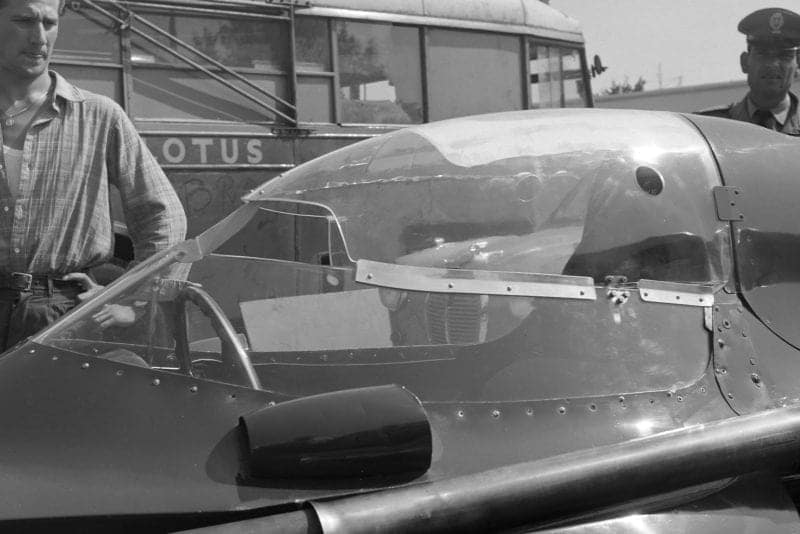
Close-up of the experimental Vanwall closed cockpit
Motorsport Images
The Vanwall team had four cars, which were the same ones they had used in Portugal, the equipment making the journey direct to Monza without returning to Acton, that is excepting the engines which were flown home for revision and flown out again. As an experiment during the first practice, one car was fitted with an enclosed cockpit cover, an extra skin being bolted on to the tail to bring the head fairing line above the drivers head and a Perspex bubble clamping onto the existing wrap-round screen once the driver was in place.
The fixing was done from inside the cockpit by over-centre catches, and there was a gap of about 3 inches at the front through which the driver could look without his vision being distorted by the Perspex. The shape of the complete dome was such that no air came in through this gap, if anything the air-flow over the front sucked air out of the cockpit. In all other respects the cars were unchanged since their last appearance, all retaining the nose mounted separate oil cooler. Only three cars were entered, the fourth being kept as a spare.
The BRM team also had four cars present, three 1958 models and a 1957 one, the old one being used in practice. Like the Vanwall team the BRM team made the journey direct front Portugal to Monza, the fourth car and transporter joining them there.
The Ferrari team were at a great advantage, being able to return to base after the Portuguese race and to give some serious thought to the braking problems on the Dino 246 car. They also had time to complete development work on a new version of the V6 engine which was the Dino 256. The normal Dino engine has a bore and stroke of 85 by 71mm giving 2,417cc capacity, hence the 246 numbering, the 6 indicating six cylinders, and the new one was 85 by 72 mm, one millimetre longer in the stroke, giving 2,451cc and to identify it as being nearer to 2.5-litre it was numbered 256. Four cars were entered for the race and all were different versions of the regular Dino Formula 1 cars used all this season, all having V6 engines.
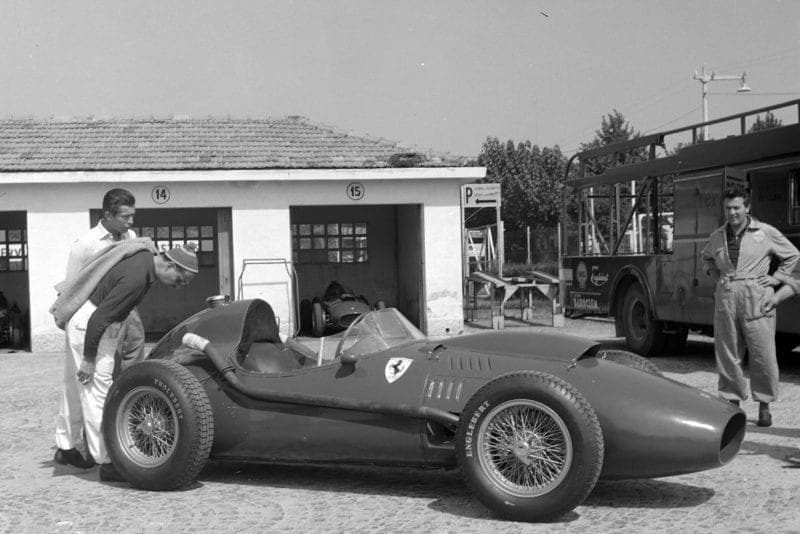
A Ferrari 246 in the paddock
Motorsport Images
There was a Formula 1 chassis, with large diameter bottom frame tubes, fitted with Houdaille vane-type shock-absorbers and Dunlop disc brakes, another similar chassis fitted with new drum brakes, a Formula II chassis, the light one, fitted with new drum brakes and the regular Houdaille shock-absorbers, and the fourth car was the experimental Monza car with coil springing at the rear, Koni shockabsorbers all round and the new drum brakes.
On the number one car the Dunlop disc brakes had been acquired from the 250GT Ferrari that used to belong to the late Peter Collins, he having had them fitted himself. There was no connection between Dunlops and Ferrari, though a fitter was loaned to Maranello to help with the assembly. The fitting of these disc brakes meant rebuilding the Ferrari wire-spoke wheels with the spokes set to the outside of the rim in order to give clearance for the caliper.
The other three cars had transverse turbo-finned drums as used in the past but instead of the whole drum being of cast-iron they were now hi-metal, of alloy with a steel liner. The experimental Monza car had revised rear springs, much longer and being mounted on a bracket that extended from below the de Dion tube. All four cars were fitted with Perspex covers over the carburetters extending far forward to an air intake at the front protected by a wire mesh screen. For the race three cars used the 246 engine and one car a new 256 engine.
Team Lotus had two cars, one 1958 and one 1957, the old one temporarily replacing the car written-off in Portugal. The 1958 car had been modified about the scuttle slightly, giving the driver more elbow-room and had a 2.2-litre engine, while the old car was fitted with a 2-litre engine for practice and a 1,500cc engine for the race.
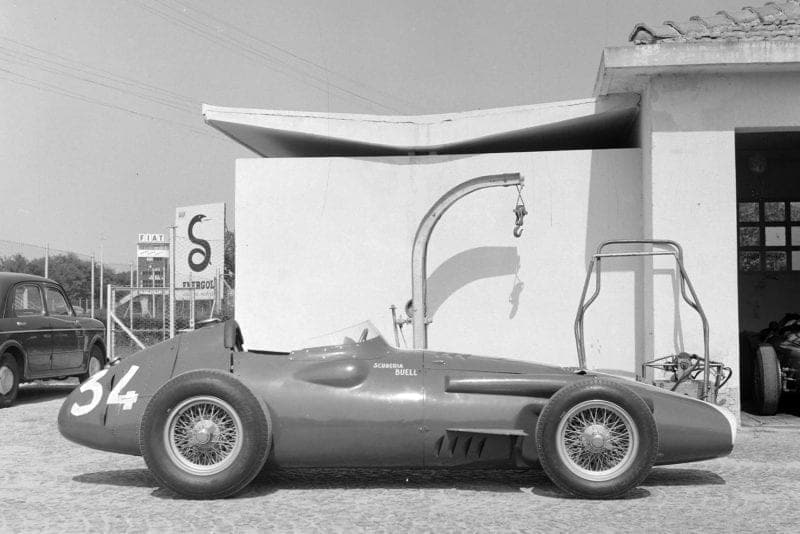
Carroll Shelby’s Maserati 250F in the paddock
Motorsport Images
Cooper had their two regular F1 cars though Salvadori’s was running with no top wishbones at the rear as this gave more oversteer than the double-wishbone layout and the driver preferred it like that. The Walker team had two cars with them, a 1958 Cooper with 2.2-litre engine and a 1957 car with 2-litre engine, the 1958 car being used in the race. In view of the high speeds at Monza this car was fitted with a special high top gear manufactured by Pippbrook Garage.
The Scuderia Temple Buell, which can be considered the works Maserati team had two 1958 cars though only one was used in the race. Built, prepared and maintained by the Modena firm it was really a works Maserati effort except that Buell was paying and choosing the drivers and handling the organisation, Maserati engineers and mechanics looking after the cars. One car was the one driven by Shelby at Portugal, this actually being the one raced at Monza, and the second car was brand new, these two being 2,533 and 2,534, respectively, following on the sequence of numbering of 250F Maseratis.
The latest car had Houdaille shock-absorbers at the front and telescopics at the rear, the other car having Houdaille all round. In other respects these two cars were identical, being the latest shortened and lightened six-cylinder 250 F mode’s, and were painted in the American, colours of blue and white.
To complete the list of cars were five more Maseratis, all old ones, Bonnier lending his ex-Godia car to Cabianca and his ex-Scarlatti car to Herrmann, while Maria-Therese de Filippis had her car repaired after her Portugal crash and the Scuderia Centro Sud entered one of their own Cars and Gerini’s car, this latter being fitted with a new body with a Vanwall-like tail.
The Centro-Sud teams own car broke in practice so they hurriedly borrowed another car from the factory, this being the one raced earlier in the season by the late Keith Campbell, but it was very much a question of starting money for the car was not in race-worthy condition.
